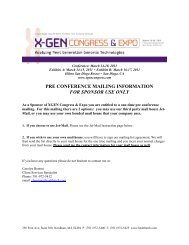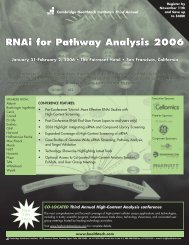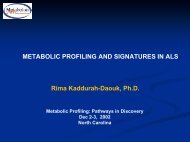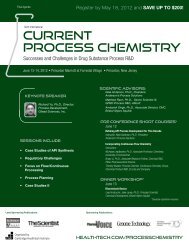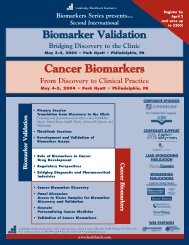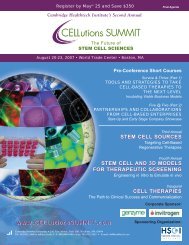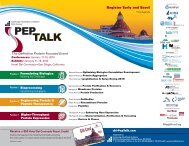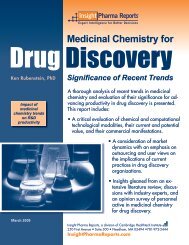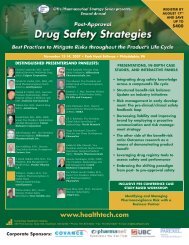Structure-Based Drug Design Conference Final Brochure.pdf
Structure-Based Drug Design Conference Final Brochure.pdf
Structure-Based Drug Design Conference Final Brochure.pdf
- No tags were found...
Create successful ePaper yourself
Turn your PDF publications into a flip-book with our unique Google optimized e-Paper software.
2:00 The Role of Recent Crystal <strong>Structure</strong>s of Membrane<br />
Bound Proteins in <strong>Drug</strong> Discovery for CNS Targets<br />
Sid Topiol, Ph.D., CSO, Computational and Structural<br />
Investigations, 3D-2<strong>Drug</strong><br />
I would present illustrations of the impact of recent X-ray<br />
structure determinations for the more challenging CNS<br />
targets, i.e., membrane bound proteins. For class C GPCR’s,<br />
new opportunities for drug discovery are being identified<br />
using X-ray structures of the extracellular regions. Other targets, such<br />
as transporters and ion channels, are also now amenable to structurebased<br />
drug design.<br />
2:25 Hitting a Moving Target: Characterizing GPCR Signaling<br />
through Long-timescale Molecular Dynamics Simulations<br />
Ron Dror, Ph.D., Senior Research Scientist and Special<br />
Advisor to the Chairman, D. E. Shaw Research<br />
A mounting body of evidence indicates that drugs<br />
induce GPCRs to interconvert between numerous<br />
conformational states with distinct intracellular signaling<br />
profiles. Recent advances in algorithms and hardware for<br />
molecular dynamics (MD) simulations are now bringing the previously<br />
inaccessible timescales on which these transitions occur within reach.<br />
This talk will describe ongoing studies of GPCRs using state-of-the-art<br />
MD simulations, which have provided a hitherto elusive glimpse of the<br />
conformational dynamics underlying GPCR-mediated signaling by both<br />
endogenous ligands and drugs.<br />
2:50 Networking Refreshment Break<br />
3:00 Beyond the Orthosteric Binding Site: A <strong>Structure</strong>-<strong>Based</strong><br />
SAR Analysis of the D3R Selective Compounds<br />
Lei Shi, Ph.D., Assistant Professor, Department of Physiology<br />
and Biophysics, HRH Prince Alwaleed Bin Talal Bin Abdulaziz<br />
Alsaud Institute for Computational Biomedicine, Weill Cornell<br />
Medical College<br />
Selective targeting of dopamine D3 receptor (D3R) has<br />
therapeutic implications in neuropsychiatric disorders and<br />
drug additions. D3R selective compounds have two pharmacophores<br />
and a connecting linker. The talk will highlight individual and combined<br />
contributions of these components towards the selectivity in the<br />
context of the D3R structure. A novel structure-based design scheme<br />
to address specificity issues of highly homologous GPCRs will be<br />
presented.<br />
3:25 Moving in New Circles – Exploiting Macrocycles for <strong>Drug</strong><br />
Discovery<br />
Nick Terrett, Ph.D., CSO, Ensemble Therapeutics Corp<br />
Macrocycles are largely underexploited in drug discovery<br />
because they are generally perceived as structurally<br />
complex and difficult to access. Ensemble Therapeutics has<br />
developed platforms for the rapid synthesis and screening<br />
of macrocycles in order to identify leads for challenging<br />
protein-protein interaction targets. The talk will focus on the design and<br />
synthesis of macrocycle libraries and the successful discovery of novel<br />
lead molecules with unprecedented activity and drug-like properties.<br />
DRUG RESISTANCE<br />
3:50 Strategizing to Develop Resistance-Proof Inhibitors<br />
Bruce Tidor, Ph.D., Professor of Biological Engineering and<br />
Computational Science, Massachusetts Institute of<br />
Technology<br />
The selection of resistant variants is an important problem<br />
limiting the therapeutic usefulness of inhibitors to targets<br />
undergoing rapid mutation, particularly for applications in<br />
infectious disease and cancer. We report our work exploring general<br />
strategies for the development of inhibitors that have a reduced<br />
tendency to induce resistance, using HIV protease as a trial target.<br />
4:15 Computational Approaches to Modeling the Emergence<br />
of <strong>Drug</strong> Resistance<br />
Ryan Lilien, M.D., Ph.D., Assistant Professor, Department of<br />
Computer Science & Donnelly Centre for Cellular and<br />
Biomolecular Research, University of Toronto<br />
The emergence of drug resistance reduces the<br />
effectiveness of many novel therapeutics. I will describe<br />
computational methods for predicting resistance mutations<br />
through their structural and functional effects on the protein target.<br />
These methods may allow us to identify new ways to create drugs that<br />
6<br />
healthtech.com/SBD<br />
are less likely to be made ineffective by pathogen evolution, understand<br />
the key determinants of the evolution and spread of resistance, and<br />
develop the ability to slow the emergence of resistant variants.<br />
4:40 End of <strong>Conference</strong>



